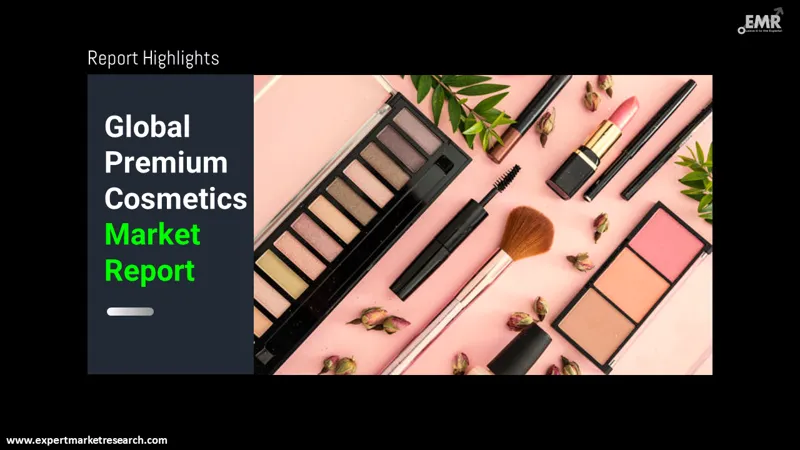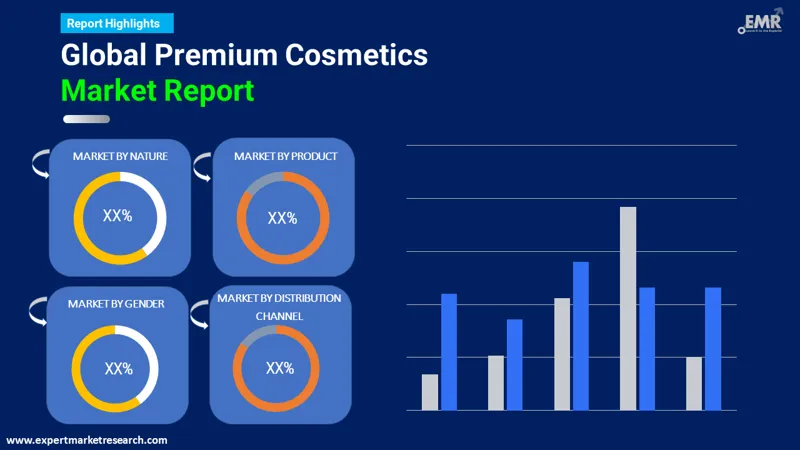
Consumer Insights
Uncover trends and behaviors shaping consumer choices today
Procurement Insights
Optimize your sourcing strategy with key market data
Industry Stats
Stay ahead with the latest trends and market analysis.
The global premium cosmetics market attained a value of USD 167.05 Billion in 2025. The market is further expected to grow in the forecast period of 2026-2035 at a CAGR of 8.70% to reach USD 384.72 Billion by 2035.
Base Year
Historical Period
Forecast Period
Compound Annual Growth Rate
8.7%
Value in USD Billion
2026-2035
*this image is indicative*
The premium cosmetics industry is led by the rising demand for natural and organic products. Premium cosmetics brands are redefining themselves in order to meet consumer’s demands while providing the best quality at the lowest price. Makeup has been used as a beauty aid for ages, and as the focus on visual aesthetics and attractiveness is increasing, the industry is witnessing significant growth. Moreover, the increasing demand for long-lasting makeup products and anti-ageing products due to the rising beauty consciousness is aiding the market growth. The rising economic independence of women consumers has increased their purchasing power, further invigorating the market growth. The development of products with ethical, experimental, innovative, and authentic qualities, along with the growing focus on longevity, is boosting the market growth. Rising awareness regarding personal grooming is also lubricating the market growth.
The rising consumer awareness and the shift from mass-produced to premium products have significantly increased in the past few years. Additionally, the demand for products with high efficiency and active ingredients is also catalysing the market growth. Moreover, increasing brand recognition and the launch of new products by the major brands are also boosting the market. Also, new makeup trends related to elevated hygiene and clean and transparent skin is expected to augment the industry growth. The rising concerns about various skin problems such as acne and pimples are also contributing to the market growth.

Read more about this report - REQUEST FREE SAMPLE COPY IN PDF
Cosmetics are any substances that are used to clean, improve, or change the complexion, skin, hair, nails, or teeth. They generally include beauty products and grooming aids. Premium cosmetics contain a ton of active ingredients. Cosmetics can be produced in the organic and hypoallergenic form to meet the consumer’s demand.
Based on nature, the premium cosmetics is segmented into:
The major products of premium cosmetics are:
The market can be broadly categorised on the basis of gender into:
Based on the distribution channel, the market is divided into:
The EMR report looks into the regional markets of premium cosmetics like:

Read more about this report - REQUEST FREE SAMPLE COPY IN PDF
The demand for cruelty-free and gluten-free products is one of the significant drivers of the industry. Additionally, brands are continuously redefining themselves in order to meet consumers’ demand for organic and cruelty-free products, for which they are reassessing their commitment to social and sustainable responsibility; the surging demand for eco-friendly products is leading the market. Moreover, the development of customised cosmetics based on a person’s skin type and facial features is also expected to aid the market growth. In addition to this, the increasing focus on supply chain and price transparency to earn the trust of the consumers is lubricating the market growth. The rising focus on overall wellbeing and conscious consumerism has increased the demand for vegan products and is providing further impetus to the market.
Digital advances and sustainable self-care products that provide unique experiences are also anticipated to boost the market. Internet penetration and the flourishing social media have widely expanded the market for premium cosmetics. Furthermore, makeup has become more gender inclusive, and men’s cosmetics is witnessing robust growth in the past few years. For instance, Chanel launched an exclusive men’s makeup line, Boy de Chanel, in South Korea, which includes tinted fluid, matte moisturising lip balm, and four shades of eyebrow pencil. The further development in the makeup for men and unisexual cosmetics is expected to propel the market growth.
The report presents a detailed analysis of the following key players in the global premium cosmetics market, looking into their capacity, market shares, and latest developments like capacity expansions, plant turnarounds, and mergers and acquisitions:
The comprehensive report looks into the macro and micro aspects of the industry. The EMR report gives an in-depth insight into the market by providing a SWOT analysis as well as an analysis of Porter’s Five Forces model.




*While we strive to always give you current and accurate information, the numbers depicted on the website are indicative and may differ from the actual numbers in the main report. At Expert Market Research, we aim to bring you the latest insights and trends in the market. Using our analyses and forecasts, stakeholders can understand the market dynamics, navigate challenges, and capitalize on opportunities to make data-driven strategic decisions.*
Get in touch with us for a customized solution tailored to your unique requirements and save upto 35%!
In 2025, the global premium cosmetics market attained a value of nearly USD 167.05 Billion.
The market is projected to grow at a CAGR of 8.70% between 2026 and 2035.
The market is estimated to witness a healthy growth in the forecast period of 2026-2035 to reach USD 384.72 Billion by 2035.
The market is being driven by the demand for organic and cruelty-free products, increasing brand recognition, and the surging consumers’ purchasing power.
The key trends guiding the market include the increasing internet penetration, digital advancements, and the rising demand for sustainable cosmetics.
The major regions in the market are North America, Latin America, the Middle East and Africa, Europe, and the Asia Pacific.
The significant segments based on nature of the product include natural and organic and conventional.
The major products in the market are skin care, hair care, makeup, and fragrance, among others.
Male, female, and unisex are the segments based on the gender.
The significant distribution channels in the market are supermarket and hypermarket, cosmetic shops, and online, among others.
The major players in the market are The Estée Lauder Companies Inc., Oriflame Cosmetics AG, L'Oréal S.A., Unilever PLC, and Elizabeth Arden, Inc, among others.
Explore our key highlights of the report and gain a concise overview of key findings, trends, and actionable insights that will empower your strategic decisions.
| REPORT FEATURES | DETAILS |
| Base Year | 2025 |
| Historical Period | 2019-2025 |
| Forecast Period | 2026-2035 |
| Scope of the Report |
Historical and Forecast Trends, Industry Drivers and Constraints, Historical and Forecast Market Analysis by Segment:
|
| Breakup by Nature |
|
| Breakup by Product |
|
| Breakup by Gender |
|
| Breakup by Distribution Channel |
|
| Breakup by Region |
|
| Market Dynamics |
|
| Competitive Landscape |
|
| Companies Covered |
|
| Report Price and Purchase Option | Explore our purchase options that are best suited to your resources and industry needs. |
| Delivery Format | Delivered as an attached PDF and Excel through email, with an option of receiving an editable PPT, according to the purchase option. |
Datasheet
One User
USD 2,499
USD 2,249
tax inclusive*
Single User License
One User
USD 3,999
USD 3,599
tax inclusive*
Five User License
Five User
USD 4,999
USD 4,249
tax inclusive*
Corporate License
Unlimited Users
USD 5,999
USD 5,099
tax inclusive*
*Please note that the prices mentioned below are starting prices for each bundle type. Kindly contact our team for further details.*
Flash Bundle
Small Business Bundle
Growth Bundle
Enterprise Bundle
*Please note that the prices mentioned below are starting prices for each bundle type. Kindly contact our team for further details.*
Flash Bundle
Number of Reports: 3
20%
tax inclusive*
Small Business Bundle
Number of Reports: 5
25%
tax inclusive*
Growth Bundle
Number of Reports: 8
30%
tax inclusive*
Enterprise Bundle
Number of Reports: 10
35%
tax inclusive*
How To Order

Select License Type
Choose the right license for your needs and access rights.

Click on ‘Buy Now’
Add the report to your cart with one click and proceed to register.

Select Mode of Payment
Choose a payment option for a secure checkout. You will be redirected accordingly.
Gain insights to stay ahead and seize opportunities.

Get insights & trends for a competitive edge.

Track prices with detailed trend reports.

Analyse trade data for supply chain insights.

Leverage cost reports for smart savings

Enhance supply chain with partnerships.

Connect For More Information
Our expert team of analysts will offer full support and resolve any queries regarding the report, before and after the purchase.
Our expert team of analysts will offer full support and resolve any queries regarding the report, before and after the purchase.
We employ meticulous research methods, blending advanced analytics and expert insights to deliver accurate, actionable industry intelligence, staying ahead of competitors.
Our skilled analysts offer unparalleled competitive advantage with detailed insights on current and emerging markets, ensuring your strategic edge.
We offer an in-depth yet simplified presentation of industry insights and analysis to meet your specific requirements effectively.
Share